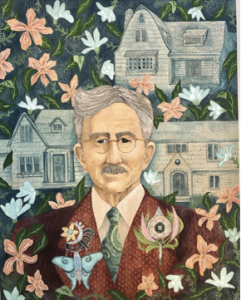
Edwin P. Albaugh (1869-1948) , referred to in his time as “The Jeweler of the Valley”, was
known to be an incredibly creative visionary and devoted husband and father. As a young man
he worked as a jeweler with Argo and Lehne Jewelers in downtown Columbus. The craftsman
specialized in heirloom jewelry using enamel and precious gems. Albaugh was also widely
know as the man who created the first ball bearing clock as well as (at the time) the worlds
largest clock.
Soon after the turn of the century, Mr. Albaugh purchased 12 acres of property in Worthington
Ohio. His land stretched across the entire valley that today consists of Kenyon Brook Dr, St.
Michaels church and school property as well as the surrounding woods on the south side of
Kenyon Brook Dr. Included within his acreage stood a house on the corner of Selby & High St.
which housed the original Kenyon College. Kenyon Brook Drive was named in its honor.
Mr. Albaugh had grad plans to take his beautiful land and transform it into a picturesque valley
rich with slopes and creeks surrounding unique, one of a kind homes inspired by various
historical architectural designs. “Kenview” stands at 1 Kenyon Brook Dr, was first built
reflecting the English Tutor style . Next came “Glengarden” at 30 Kenyon Brook Dr in the
Elizabethan style and lastly, “Willow Mill” 60 Kenyon Brook Dr was inspired by Mexican design.
Unfortunately, the Great Depression hit and Albaugh was forced to sell his beloved homes and
property.
As the current owner of “Glengarden”, I wanted to pay homage to a fellow artist and
inspirational man. My family is only a brief part of our homes history that Edwin Albaugh
started nearly one hundred years ago. Using old photographs, articles and magazine clippings
passed down from owner to owner, I created this illustrative portrait. In it, Edwin proudly wears
a few examples of his impressive enamel jewelry on his lapel. He stands with his three homes
as they were when they were originally built, surrounded by the flowers he was known to plant
to set his valley ablaze with color.
Many of Edwin Albaugh’s materials can be viewed at the Worthington Historical Society.
